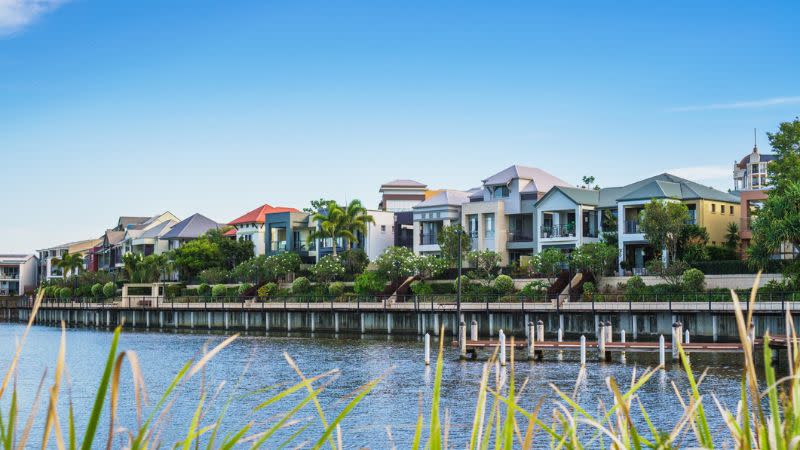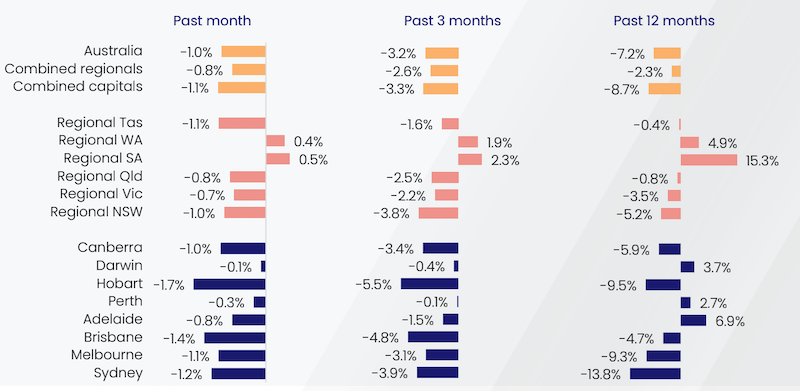Freefall of Pumped-Up Home Values Losing Pace

Australia’s housing values are still rapidly coming off the boil as the market cool-down continues but the rate of decline is showing early signs of slowing in most capital cities.
Nevertheless, January marked a record for how much and how fast home values have fallen across the nation.
CoreLogic’s national Home Value Index has plunged 8.9 per cent nationally since peaking in April last year in what has been the largest and fastest decline in housing values since its records began in 1980.
Brisbane and Hobart have logged record declines of 10.8 per cent while Sydney home values are down 13.8 per cent and not far off surpassing the city’s 2017-19 record drop of 14.9 per cent.
But on the upside, although housing values fell a further 1 per cent in January it was a slight improvement on December’s 1.1 per cent decline and the smallest drop recorded since June last year.
Across the capital cities, the month-on-month drop in values ranged from 1.7 per cent in Hobart to 0.3 per cent in Perth, where—along with Adelaide, down 0.8 per cent—values have held firmer since interest rates began rising in May.
Sydney’s median dwelling value fell 1.2 per cent in January—dropping below $1 million for the first time since March 2021.
Putting it all in context, CoreLogic research director Tim Lawless said: “Record declines in home values follow a record upswing, both in magnitude and speed. The national HVI was up a stunning 28.6 per cent in the space of just 19 months.
“Despite the recent sharp drop in values, every capital city and rest-of-state region is still recording home values above pre-pandemic levels, although Melbourne’s index would only need to fall a further 0.4 per cent before equaling the March 2020 reading.”

Through January, regional housing values continued to record a milder rate of decline than each of their capital city counterparts. Since peaking in June, the combined regionals index is down 7.4 per cent while capital city values are now 9.6 per cent below their April peak.
The monthly fall in values for January in the rest-of-state regions ranged from 0.7 per cent in regional Victoria to 1.1 per cent in regional Tasmania. Both Western Australia and South Australia recorded positives of 0.4 per cent and 0.5 per cent respectively.
Lawless said the housing downturn remained geographically broad-based but there were emerging signs that the decline in values was losing some momentum.
“The quarterly trend in housing values is clearly pointing to a reduction in the pace of decline across most regions, however at -1.0 per cent over the month and -3.2 per cent over the rolling quarter, national housing values are still falling quite rapidly compared to previous downturns,” he said.
According to the data, the most noticeable easing in value falls had been across the premium end of the housing market, improving from a recent low of -6.1 per cent during the September 2022 quarter to -4 per cent in the three months to January.
Change in homes values to end of January 2023

“While this trend towards improving conditions across premium markets is not evident in all cities, it is most apparent in Sydney’s detached house market,” Lawless said. “Quarterly declines in this market segment eased from -7.7 per cent in the three months to August to -3.9 per cent in the three months to January.
“The improvement could be reflective of more buyers taking advantage of larger price drops across the premium sector, where house values are down 17.4% since peaking in January 2022,” he said.














